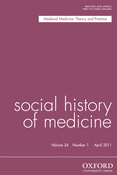-
Views
-
Cite
Cite
Mark Jackson, Fay Bound Alberti, Matters of the Heart: History, Medicine, and Emotion, Social History of Medicine, Volume 24, Issue 1, April 2011, Pages 186–187, https://doi.org/10.1093/shm/hkr017
Close - Share Icon Share
Extract
Unlike the heart, which could be understood as both structurally and functionally unbalanced, this book possesses an elegant symmetry. Tracing competing, or at least alternative, visions of the heart as symbol and organ from the seventeenth through to the late nineteenth century, Matters of the Heart offers an intricate and balanced cultural history of an organ that has occupied a pivotal, albeit contested, position in modern accounts of emotional and physical health. As Alberti suggests at various points, a longue durée approach allows readers to recognise and understand key continuities and shifts in clinical formulations and patient experiences of both healthy and diseased hearts. In the process, this book contributes not only to the deep histories of cardiology and emotions, but also to wider disputes within the history of medicine about the processes, and implications, of increasing scientific specialisation and secularisation within medical practice.
The book revolves around a number of significant polarities or dichotomies between: mind and body; the heart as a symbol and an organ; brain and heart; health and disease; functional and organic diseases; male and female; and so on. In general, Alberti argues, the heart has been reconceptualised by modern medical technologies as an organ, partially stripped of its emotional currency. As new diagnostic tools and pathological insights began to equate certain symptoms and disorders with faulty cardiac structure and function during the long nineteenth century, and as the brain began to emerge as the idealised site for cognition, emotion and identity, older humoral understandings of the heart as the seat, or active agent, of passion and feeling were swept away by the belief that the heart's variable pulsations were merely passive reactions to electrical stimulation generated by the autonomic nervous system; once at the physical and metaphysical centre of the body and its functions, the heart became merely another organ, responding like the stomach or the limbs to the mind's (or brain's) instructions. Both these transitions, from heart to brain and from symbol to organ, as well as the finely-nuanced gendering of heart diseases, are illustrated by a series of case studies, or as Alberti puts it, by ‘a series of sections or slices of the heart, served up at various points throughout the book in order to locate or analyse its meanings’ (p. 160). Thus, Alberti revisits the ill-health and deaths of John Hunter, Thomas Arnold and Harriet Martineau, and traces changing accounts of the heart in the writings of many British and continental European physicians.




